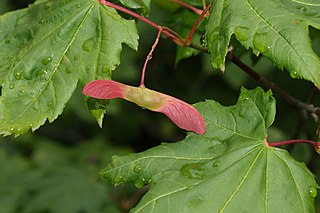
A samara is a winged achene, a type of fruit in which a flattened wing of fibrous, papery tissue develops from the ovary wall. A samara is a simple dry fruit and indehiscent. The shape of a samara enables the wind to carry the seed farther away than regular seeds from the parent tree, and is thus a form of anemochory.
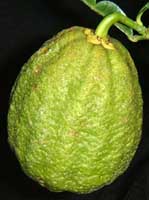
Citrus cavaleriei, the Ichang papeda, is a slow-growing species of papeda that has characteristic lemon-scented foliage and flowers.

Ptelea trifoliata, commonly known as common hoptree, wafer ash, stinking ash, and skunk bush, is a species of flowering plant in the citrus family (Rutaceae). It is native to North America, where it is found in Canada, Mexico, and the United States. It is a deciduous shrub or tree, with alternate, trifoliate leaves.

The trifoliate orange, Citrus trifoliata or Poncirus trifoliata, is a member of the family Rutaceae. Whether the species should be considered to belong to its own genus, Poncirus or included in the genus Citrus is debated. The species is unusual among citrus for having deciduous, compound leaves and pubescent (downy) fruit.

Ptelea is a genus of flowering plants in the citrus family, Rutaceae. The name, of Greek derivation, is the classical name of the elm tree. Carl Linnaeus used that word for this genus because of the resemblance of its fruit to that of the elm. Members of the genus are commonly known as hoptrees.

Menyanthes is a monotypic genus of flowering plants in the family Menyanthaceae containing the single species Menyanthes trifoliata. The name Menyanthes comes from the Greek words menyein, meaning "disclosing", and anthos, meaning "flower", in reference to the sequential opening of flowers on the inflorescence. The North American form is often referred to as M. trifoliata var. minor Michx. It is known in English by the common names bogbean and buckbean.

Myrica is a genus of about 35–50 species of small trees and shrubs in the family Myricaceae, order Fagales. The genus has a wide distribution, including Africa, Asia, Europe, North America and South America, and missing only from Australia. Some botanists split the genus into two genera on the basis of the catkin and fruit structure, restricting Myrica to a few species, and treating the others in Morella.

The Donald E. Davis Arboretum is an arboretum located on the campus of Auburn University in Auburn, Alabama. It is open to the public without charge.

Piranhea is a plant genus under the family Picrodendraceae described as a genus in 1866.
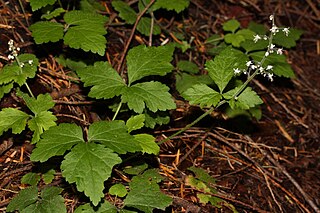
Tiarella trifoliata, commonly called threeleaf foamflower, laceflower, or sugar-scoop, is a dicot in the family Saxifragaceae.
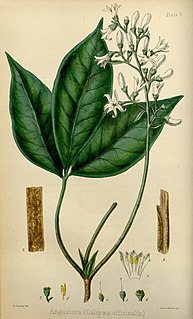
Angostura trifoliata is a plant native to South America. It is an evergreen, growing 18 to 24 metres tall. The leaves are composed of three ovoid lanceolate leaflets. The flowers are purplish-white.
P. trifoliata may refer to:
Borthwickia is genus of flowering plants, containing one species, Borthwickia trifoliata from Yunnan, China and Myanmar. The common name in Chinese is 节蒴木. It is a shrub or small tree with evergreen trifoliate leaves, whitish flowers clustered at the tip of the branches, with many stamens, and thin, knobbly, drooping fruits with many small red seeds.

Hypelate trifoliata, commonly known as white ironwood or inkwood, is a small tree in the soapberry family. It is native to extreme southern Florida and islands of the Caribbean. It has trifoliate leaves and produces small flowers in early summer.

Cossinia is a genus of four species of rainforest trees, constituting part of the plant family Sapindaceae. The genus has a disjunct distribution, occurring in Mascarene Islands, Australia, New Caledonia and Fiji.
Citrus rootstock are plants used as rootstock for citrus plants. A rootstock plant must be compatible for scion grafting, and resistant to common threats, such as drought, frost, and common citrus diseases.
Citrumelo or Citromelo is also called Swingle citrumelo trifoliate hybrid, because it is a cold hardy citrus hybrid between a 'Duncan' grapefruit and a trifoliate orange, developed by Walter Tennyson Swingle.

The Médio Purus Extractive Reserve is an extractive reserve in the state of Amazonas, Brazil.

The Purus várzea (NT0156) is an ecoregion of seasonally flooded várzea forest in the central Amazon basin. It is part of the Amazon biome. The ecoregion is home to a vegetation adapted to floods of up to 12 metres (39 ft) that may last for eight months. There is a great variety of fish and birds, but relatively fewer mammals. Ground-dwelling mammals must migrate to higher ground during the flood season. Threats include logging, cattle farming, over-fishing and mercury pollution from gold mining.
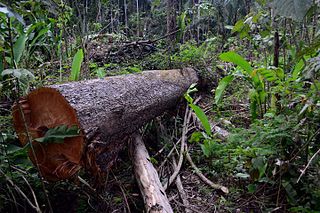
The Tapajós–Xingu moist forests (NT0168) is an ecoregion in the eastern Amazon basin. It is part of the Amazon biome. The ecoregion extends southwest from the Amazon River between its large Tapajós and Xingu tributaries.
















